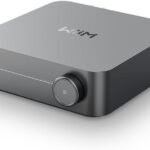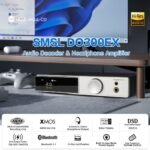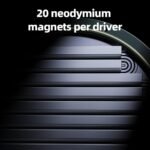Have you ever wondered how headphones are able to produce such incredible sound quality? It all comes down to the technology behind them. In recent years, there has been a surge in popularity for a specific type of headphone called planar magnetic headphones. These headphones use a unique audio driver technology that allows for a more accurate and detailed sound reproduction. In this article, we will explore the rise of planar magnetic headphones, diving into the technology responsible for their impressive sound and the reasons why they have gained such a devoted following among audio enthusiasts.
Planar Magnetic Technology: An Overview
Planar magnetic technology has revolutionized the world of headphones with its innovative design and exceptional sound quality. This article provides an in-depth exploration of this cutting-edge technology, starting with a historical overview and delving into the scientific principles behind its functioning. We will also compare planar magnetic technology with traditional dynamic drivers to understand its advantages and limitations.
Historical development of planar magnetic technology
The roots of planar magnetic technology can be traced back to the mid-1970s when Dr. Oscar Heil first introduced the concept of using a thin, flat diaphragm in audio drivers. However, it was only in the 1990s that this technology gained significant traction, primarily thanks to the efforts of companies like Magnepan and Orthodynamic.
Scientific principles behind planar magnetic technology
At the core of planar magnetic technology lies the principle of electromagnetic induction. Unlike dynamic drivers that rely on a coil and a cone-like diaphragm, planar magnetic drivers utilize a thin, lightweight diaphragm embedded with conductive traces. These traces interact with a static magnetic field generated by a series of magnets, resulting in the production of sound.
Comparing planar magnetic with dynamic drivers
One of the primary advantages of planar magnetic headphones is their ability to accurately reproduce sound across the entire frequency spectrum. Dynamic drivers, on the other hand, often struggle with reproducing high-frequency details and suffer from distortion at high volumes. However, dynamic drivers have traditionally been more efficient and affordable, making them widely used in consumer headphones. Nonetheless, planar magnetic technology is gaining popularity due to its superior sound quality and improved performance.
Components of Planar Magnetic Headphones
To fully understand how planar magnetic technology works, it is essential to delve into the various components that make up these headphones. This section will explore the magnet structure, the role of the diaphragm, and the construction of the voice coil.
Understanding the magnet structure
The magnet structure in planar magnetic headphones plays a crucial role in the overall sound reproduction. These headphones typically feature an array of neodymium magnets, strategically placed on either side of the diaphragm. The magnetic field created by the magnets interacts with the conductive traces on the diaphragm, resulting in sound production.
The role of the diaphragm in sound production
The diaphragm in planar magnetic headphones is a thin film made of various materials, such as Mylar or other polymers. It is responsible for converting electrical signals into sound waves. Due to its lightweight and even surface, the diaphragm can accurately reproduce sound across the entire frequency spectrum.
Construction of the voice coil
The voice coil in planar magnetic headphones is embedded within the diaphragm and is connected to the conductive traces. When an audio signal is passed through the voice coil, it interacts with the magnetic field generated by the magnets, causing vibrations in the diaphragm. These vibrations result in the production of sound waves.
Pros and Cons of Planar Magnetic Headphones
While planar magnetic headphones offer a range of benefits, they also come with their own set of drawbacks that users need to consider. This section will explore the sound quality advantage, durability, weight and size disadvantage, and cost-related implications associated with planar magnetic headphones.
Sound quality advantage
One of the standout features of planar magnetic headphones is their exceptional sound quality. With their ability to reproduce sound accurately and provide a wider soundstage, planar magnetic headphones offer an immersive listening experience. The detailed imaging and precise instrument separation contribute to an immersive soundstage that is highly sought after by audiophiles and music professionals.
Durability and long-lasting use
Planar magnetic headphones are known for their durability and longevity. The absence of moving parts and the solid construction of the diaphragm make these headphones less prone to wear and tear. This durability ensures that users can enjoy high-quality sound reproduction for an extended period without worrying about the performance degradation commonly associated with dynamic drivers.
Weight and size disadvantage
One of the limitations of planar magnetic headphones is their weight and bulkiness compared to other headphone types. The magnets used in these headphones add significant weight, making them less suitable for extended wearing sessions. The larger size can also limit portability, making them less practical for on-the-go use.
Cost-related implications
Planar magnetic headphones are generally more expensive compared to dynamic headphones due to their complex manufacturing process and the use of premium-quality materials. The advanced technology, meticulous design, and high-quality components contribute to the higher price tag. However, with advancements and increased popularity, the entry-level options provide a more affordable option for budget-conscious consumers.
Exploring Sound Quality of Planar Magnetic Headphones
When it comes to sound quality, planar magnetic headphones stand out from the crowd. This section will delve into the differences in soundstage and imaging, bass response and mid-range clarity, treble extension and detail retrieval, and the multidimensional sound experience that planar magnetic headphones offer.
Differences in soundstage and imaging
Planar magnetic headphones excel in creating a spacious and immersive soundstage. The accurate imaging allows users to pinpoint the location of individual instruments and vocals, making for a more realistic listening experience. The wider soundstage adds depth and dimension to the music, enhancing the overall enjoyment for listeners.
Bass response and mid-range clarity
One of the strengths of planar magnetic headphones is their exceptional bass response. The precise control over the diaphragm and the efficient drive of the magnets result in tight, impactful bass reproduction. Additionally, the mid-range clarity is impressive, ensuring that vocals and instruments are reproduced with accuracy and detail.
Treble extension and detail retrieval
With their ability to reproduce high-frequency details with precision, planar magnetic headphones offer an extended treble response. The diaphragm’s even surface and lightweight construction enable the accurate reproduction of delicate nuances in the music, providing a more immersive and engaging listening experience.
Multidimensional sound experience
The combination of the wide soundstage, precise imaging, excellent bass response, and extended treble results in a multidimensional sound experience that truly captivates the listener. Planar magnetic headphones allow for a close-to-real-life representation of the music, bringing out subtle nuances and details that are often missed with other headphone technologies.
Influence on the Headphone Market
The rise of planar magnetic headphones has had a profound impact on the headphone market. This section will explore how these headphones have gained popularity among audiophiles, the impact on the professional audio industry, and the shift manufacturers are making towards adopting planar magnetic technology.
Rise in popularity among audiophiles
Audiophiles, who are known for their discerning taste in sound quality, have embraced planar magnetic headphones due to their exceptional sonic capabilities. These headphones cater to the audiophile desire for accurate and detailed sound reproduction, making them highly sought after by this niche group.
Impact on the professional audio industry
The professional audio industry has also recognized the benefits of planar magnetic headphones. Sound engineers, musicians, and producers rely on accurate sound reproduction and precise imaging to create and mix music. Planar magnetic headphones provide a reliable and accurate reference for such professionals, allowing them to make informed decisions during the production process.
Manufacturers’ shift towards planar magnetic technology
In recent years, there has been a noticeable shift among headphone manufacturers towards embracing planar magnetic technology. Companies like Audeze, Hifiman, and Oppo Digital have been at the forefront of this movement, producing high-quality planar magnetic headphones that cater to a wide range of users. As the demand for planar magnetic headphones grows, more manufacturers are expected to incorporate this technology into their product lineups.
Brand Case Studies
Several brands have emerged as pioneers in the planar magnetic headphone market. This section will examine the success story of Audeze, Hifiman’s contribution to planar technology, and the unique approach of Oppo Digital in the development of planar magnetic headphones.
Audeze’s success story
Audeze, founded in 2008, has established itself as one of the leading manufacturers of planar magnetic headphones. With their commitment to innovation and uncompromising sound quality, Audeze has received critical acclaim and a dedicated following. Their LCD series headphones have become synonymous with high-end planar magnetic audio reproduction.
Hifiman’s contribution to planar technology
Hifiman, a renowned brand in the audio industry, has made significant contributions to planar magnetic technology. They have continually pushed the boundaries of design and performance, delivering exceptional sound quality at various price points. Hifiman’s focus on affordability and accessibility has made planar magnetic headphones more attainable for a broader audience.
The unique approach of Oppo Digital
Oppo Digital took a unique approach to planar magnetic headphones by incorporating their expertise in digital audio technology. This resulted in the production of planar magnetic headphones that offered exceptional sound quality and included advanced features such as wireless connectivity and built-in amplifiers. Oppo Digital’s commitment to innovation has established them as a prominent player in the planar magnetic headphone market.
Common Misconceptions about Planar Magnetic Headphones
Planar magnetic headphones are often misunderstood, leading to various misconceptions. In this section, we will debunk some common assumptions about planar magnetic headphones, including power requirements, weight and comfort concerns, and performance in the low-end frequency range.
Correcting assumptions on power requirements
Contrary to popular belief, planar magnetic headphones do not necessarily require high-power amplification. While it is true that they may benefit from sufficient power to unleash their full potential, many planar magnetic headphones can be adequately driven by portable players and smartphones. The development of more power-efficient drivers has made planar magnetic headphones increasingly accessible to a wider range of users.
Breaking down myths on weight and comfort
One misconception about planar magnetic headphones is that they are heavy and uncomfortable to wear for extended periods. While it is true that planar magnetic headphones tend to be heavier than their dynamic counterparts, advancements in design and materials have led to more lightweight models. Additionally, manufacturers have made efforts to improve the ergonomics and comfort of these headphones, allowing for longer listening sessions without discomfort.
Dispelling beliefs on low-end performance
Another misconception is that planar magnetic headphones struggle with low-end frequencies, particularly in terms of bass response. However, modern planar magnetic headphones have overcome this limitation with advancements in driver design and construction. Many models now offer deep, impactful bass reproduction that rivals or even surpasses that of dynamic headphones, providing a satisfying low-end performance.
Availability and Affordability
As planar magnetic technology becomes more established, a wider range of headphones incorporating this technology has become available. This section will discuss the availability of planar magnetic headphones across different price ranges, a comparison with dynamic and electrostatic headphones, and predictions for future price trends.
Range of products from budget to premium
Planar magnetic headphones are now available in a range of price points, catering to various budgets. While high-end options from established brands may command a premium price, entry-level and mid-range models have become increasingly affordable. This widening availability allows more consumers to experience the benefits of planar magnetic sound without breaking the bank.
Comparison with dynamic and electrostatic headphones
When comparing planar magnetic headphones with dynamic and electrostatic headphones, each technology has its strengths and weaknesses. Dynamic headphones are generally more efficient and affordable, making them popular in the consumer market. Electrostatic headphones offer unparalleled detail and transparency but require specialized amplification. Planar magnetic headphones strike a balance between the two, offering excellent sound quality with a wider range of compatibility and affordability.
Predicting future price trends
As with any technology, it is expected that planar magnetic headphones will become more affordable over time. With advancements in manufacturing, increased competition, and economies of scale, the cost of producing planar magnetic headphones is likely to decrease. This trend will make these headphones more accessible to a broader audience, fostering wider adoption of planar magnetic technology in the future.
Maintaining and Troubleshooting Planar Magnetic Headphones
To ensure optimal performance and longevity, proper maintenance and troubleshooting techniques are essential for planar magnetic headphones. This section will provide care and cleaning tips, outline common problems that may arise, and offer recommendations for repairs and replacements.
Care and cleaning tips
Planar magnetic headphones require regular care to keep them in optimal condition. It is important to avoid exposing them to extreme temperatures and moisture. Cleaning the earpads and diaphragm regularly using a soft cloth or specialized cleaning solutions can help maintain their performance. Additionally, storing them in a protective case when not in use prevents damage.
Understanding common problems
While planar magnetic headphones are generally reliable, some common problems may occur. These include driver imbalance, cable issues, and wear on the earpads. Driver imbalance can be resolved by checking the connections and ensuring they are secure. Cable problems can often be fixed by replacing the cable. The wear on the earpads can be mitigated by following the manufacturer’s recommendations for replacing them.
Recommendations for repairs and replacements
If issues persist or serious damage occurs, it is recommended to reach out to the manufacturer or an authorized technician for repairs. Most reputable brands offer repair services or replacement components, ensuring that users can continue to enjoy their planar magnetic headphones for years to come.
The Future of Planar Magnetic Technology
Planar magnetic technology continues to evolve, with innovations in design and materials pushing the boundaries of sound reproduction. In this section, we will explore the potential for planar magnetic headphones in wireless and active noise cancelling technology and discuss the broader implications for other audio technologies.
Innovations in design and materials
Manufacturers are continuously working on improving the design and materials used in planar magnetic headphones. This includes advancements in driver construction, magnet arrays, and diaphragm materials. These innovations aim to further enhance the sound quality and comfort of planar magnetic headphones, providing even more immersive listening experiences.
Potential in wireless and active noise cancelling headphones
Wireless connectivity and active noise cancelling are two areas where planar magnetic technology has the potential to make significant advancements. The ability to incorporate wireless technology without compromising sound quality has the potential to revolutionize the wireless headphone market. Additionally, the precise control over the diaphragm in planar magnetic headphones makes them ideal for integrating active noise cancelling, allowing for a more immersive and undisturbed listening experience.
Implications for other audio technology
The advancements in planar magnetic technology have broader implications for other audio technologies. The precise control over diaphragm movement and accurate sound reproduction can be leveraged in areas such as loudspeakers and in-ear monitors. Additionally, the efficiency and sound quality of planar magnetic headphones can inspire further developments in audio-related fields, driving innovation for years to come.
In conclusion, planar magnetic technology has established itself as a game-changer in the world of headphones. The historical development, scientific principles, and components of planar magnetic headphones all contribute to their exceptional sound reproduction. While they come with their own pros and cons, their superior sound quality and durability have made them increasingly popular among audiophiles and professionals. As the headphone market continues to evolve, planar magnetic technology is poised to play a significant role, driving innovation and shaping the future of audio.










